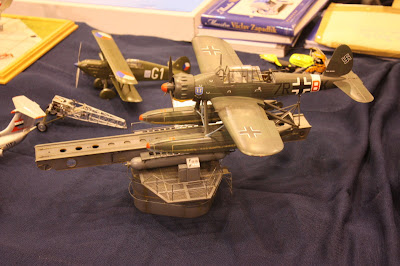The latest volumes in the 'Air Miniatures' unit history series from Kagero devoted to JG 51 and JG 52 are currently available through distributor Casemate Publishing (click on banner link above) and I suggest you purchase them before they sell out. These newer titles are printed in the much larger A-4 size compared to previous titles in this series and although still with dual text, contain plenty of well-written, previously unpublished personal accounts newly translated from hard-to find German sources.
Both titles cover the period from the beginning of Operation Barbarossa in June 1941 to roughly April 1942 in a combat diary format. II./JG 51 Gruppenkommandeur Hptm. Josef Fözö describes the opening day of the campaign in an extract from his 1943 account " Freie Jagd von Madrid bis Moskau; ein Fliegerleben mit Mölders ";
" We have barely been out of our cockpits. Five times we have been up today on the first day of the campaign in the East. Each time we return with our eyes almost glued shut with sweat and dust, our lips parched and out our throats thick and sticky with thirst. Mölders seems to be everywhere one looks. He went up with one of the Gruppen but was soon back on the ground in his command post. He exchanges information with the minimum of words, only quick-fire questions and answers. He has already devised another attack; " ..fly a sweep behind the lines - take Hannes with you !" He meant Kolbow, the best Staffelkapitän in my Gruppe. Mölders instructions during his short briefing were ; " ..if you don't see anything in the air, check out the ground there are two airfields around the town...". We quickly took to the air. The landscape rolled below. Where were those Ratas, where are the damned bumblebees? Looks like the lads from the Red Air Force don't know there is a war on..here we go! ..banking down towards the first of the two airfields.. I count forty Russian machines..no, 45. The show is on. Spurts of dirt kicked up by our slugs cross the airfield..dust billows up...every single machine down there gets plastered..!"


Both Geschwader (not forgetting the plural of 'Geschwader' is 'Geschwader' !) were flying Bf 109Fs and their ace pilots were to return huge scores. But after the initial shock and awe the Russians fought back with a bravery that astounded their German counterparts. As aces of the calibre of Staffelkapitän 12./JG51 Oblt. Heinz Bär were to discover, even Ratas and Sturmoviks could be dangerous opponents - Bär was forced to bale out behind Russian lines on 31 August 1941 and the book opens with an account of this combat and the German pilot’s subsequent trek back to safety. The book has many more personal stories from the pilots portraying the tension, the exhilaration and very often the fear under which they flew.
In addition to some riveting first-hand reports, each title features an excellent action print on the cover by Arkadiusz Wrodel, a fold-out centre spread with three profile artworks and another two superbly rendered side-views on the back over. The machines featured in the artwork appear on the very nice decal sheets included in each title in three scales and in many instances there is a reference photo normally only seen in those hard-to-find (and very expensive) German-language sources to back up the artist's interpretation. In the JG 52 book the machines illustrated are Uffz. Alfred Grislawski's F-4, W.Nr.7034, coded “Yellow 9” of 9./JG 52 (25 October 1941), Rudolf Resch, the Staffelkapitän of 6./JG 52 ( an F-2, W.Nr. 12848, coded “Yellow 1”), Fw. Josef Zwernemann of 7./JG 52 (an F-4, coded “White 8”), Geschwaderkommodore Maj. Hans Trubenbach's F-4 W.Nr. 7087 (“Black Double Chevron”, 15 July 194) and Gruppenkommandeur of II./JG 52, Oblt. Johannes Steinhoff (F-4, W.Nr. 13744, coded “Black Double Chevron”).

The JG 51 book covers Obstlt. Werner Molders' F-2, Lt. Hans Strelow's F-2, of 5./JG 51 (coded “Black 10” in winter camouflage), Fw. Werner Bielefeld's F-2 of 7./JG 51 (“White 11” as seen on 11 July 1941), Staffelkapitän Oblt. Erich Hohagen's F-2 “White 1” of 4./JG 51 and another Staffelkapitän, Oblt. Heinrich Krafft's F-4 of 3./JG 51, W.Nr. 7221, “Yellow 7” as photographed in February 1942 - all in all two superb decal sets.
With all the superb Bf 109F kits released this year you might well need some inspiration with colour schemes and decals - with these two volumes you will have plenty of choice. Even if you're not about to break open the Zvezda or Trumpeter kits then there is still plenty of material here for a damn good read !
Thanks to Casemate UK for the samples.















































